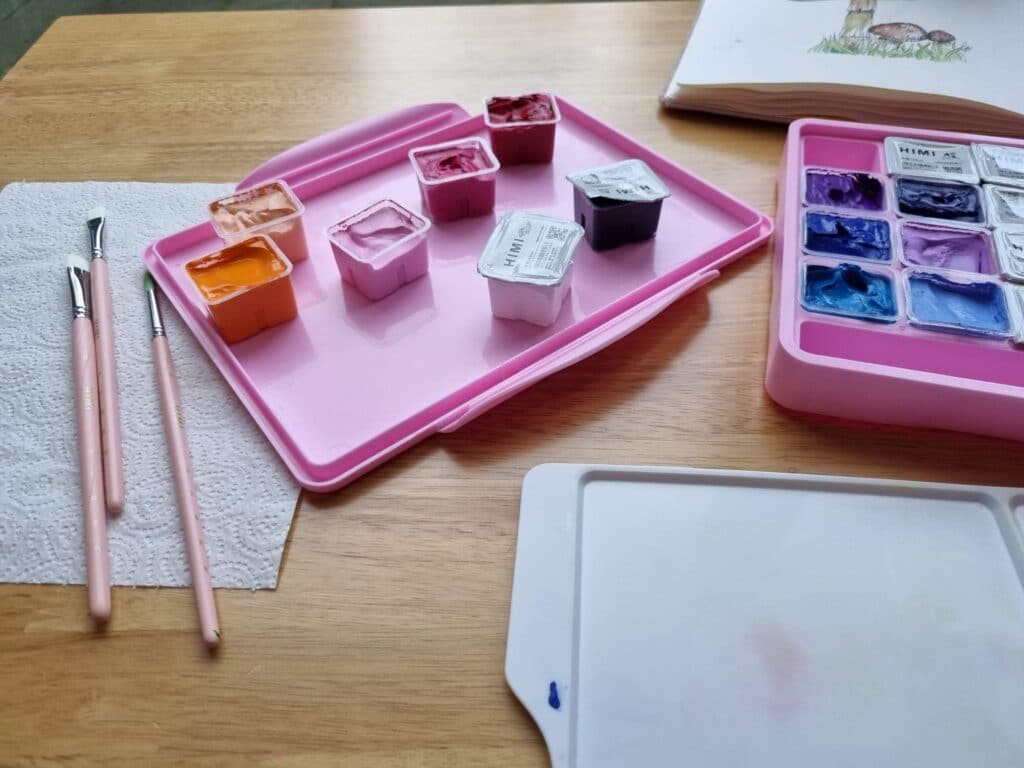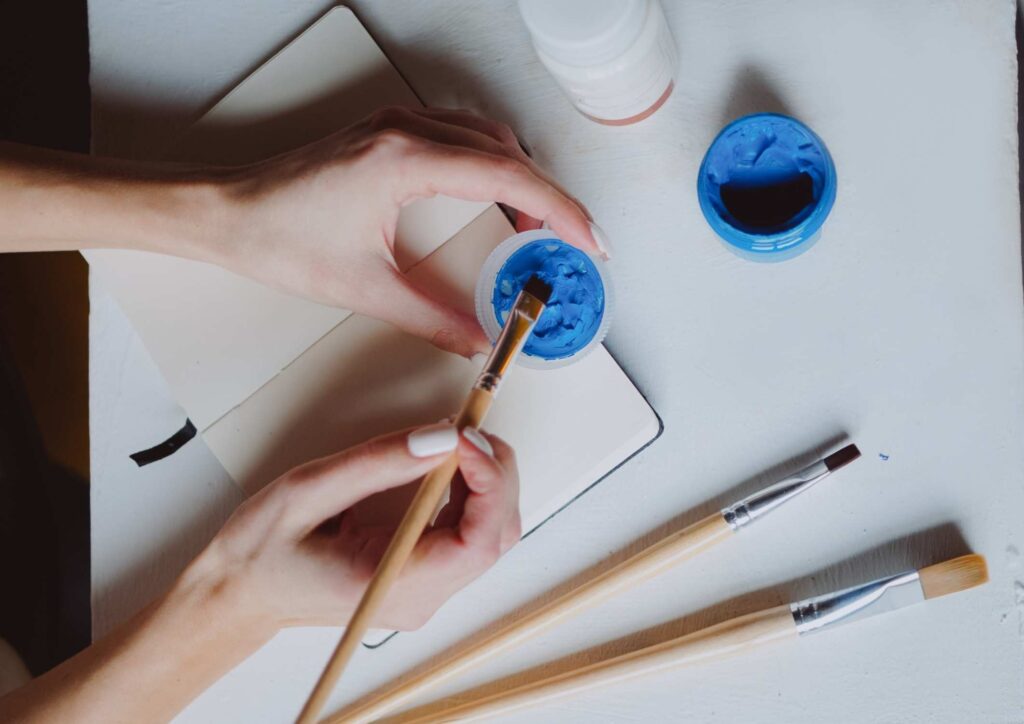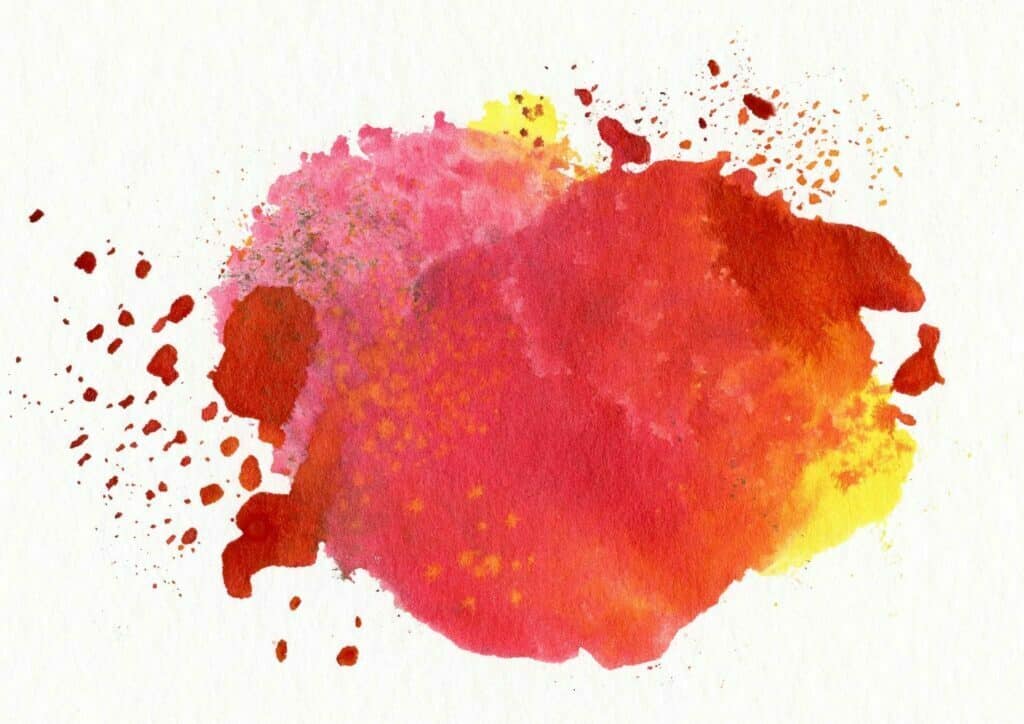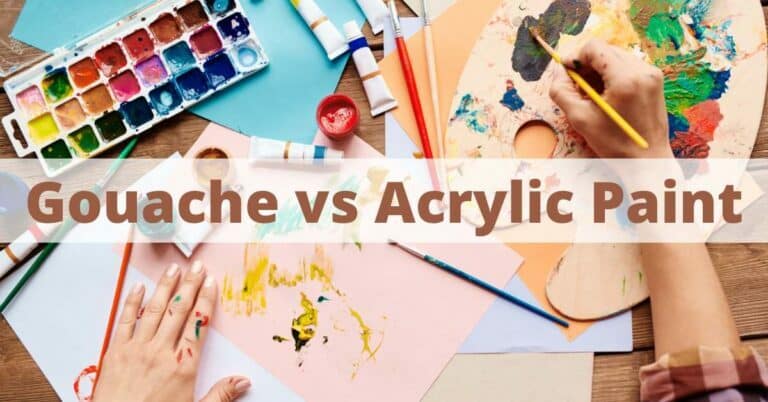Last Updated on June 24, 2023 by Dee
Choosing between gouache vs acrylic paint can be difficult. They both have their own unique characteristics and benefits. So, which one is right for you?

In this blog post, we’ll take a look at the differences between gouache and acrylic paint, as well as some of the pros and cons of each type of paint. We’ll also provide tips on choosing which type of paint is right for your artwork.
**This page may contain affiliate links to products I have used or recommend. If you purchase something from this page, I may receive a small percentage of the sale at no extra cost to you.**
What’s the difference between gouache paint and acrylic paint?
So if you have tried a variety of painting mediums you will notice that gouache paint works in a very similar way to watercolor paint.
The main difference between gouache vs acrylic is that gouache has a matte dense pigment whereas watercolor pigment is transparent.
Acrylic Paints are also crafted from dense pigment in combination with an acrylic medium and a plastic binder.
Watercolor or gouache are water-based paints that contain water. Water-based media means the painting is not water-resistant and can be lifted or activated when wet.
What is so great about jelly paint? Himi Gouache Paint Set Review

Gouache vs Acrylic Binders
Gouache and acrylic paint are both made up of a combination of dry pigment and a binder. The binder is the glue that keeps the pigments in place and adheres to the canvas or paper.
The binder in each painting medium determines the characteristics of the paint and the way you can use it to make a painting.
Gum arabic is a binder in gouache paint, whereas acrylic paints utilize an acrylic polymer as a binder.
Gum arabic, the hardened sap of Acacia trees, has several applications. It’s employed in food and cosmetics, among other things. Gum arabic is a type of resin that comes from certain acacias.
Essentially, Gouache paint has the same binder that’s used in watercolors. It may split when you apply it in thick layers because it is water-soluble.
On the other hand, Acrylic paint employs an emulsion that is soluble when wet but is water-resistant when dry.
Acrylic paint becomes like a fluid, flexible, and stretchy plastic sheet on paper.

Water Resistance
Acrylic vs gouache: water resistance? Both gouache and acrylic paint are water-soluble. The difference between the two comes into play when they dry.
Acrylic paints dry and become water-resistant. This means you can paint layer on top of the dry layer without the topcoat mixing with the base layer – you can add as many layers as you want.
You can correct mistakes easily by allowing the paint to dry and then paint over it. However, it takes about 7 minutes for acrylic paint to dry (depending on the weather) and you should only paint a new layer over a layer that is completely dry.
Durability
Gouache will fade if it’s constantly exposed to sunlight.
Premium Acrylic paint is non-fading, meaning that it will not change color or deteriorate when exposed to light.
How long do gouache paintings last?
Gouache paintings will last indefinitely if they are stored in a dark, dry place.
Sealing and Framing Gouache vs Acrylic Paintings
Once you are done painting with Gouache, you will need to seal the painting with an acrylic varnish otherwise, it will fade over time.
Acrylic paintings do not require sealing and can be framed without a glass cover.
Acrylic paints
When looking at gouache paint vs acrylic, acrylic paints are pigment bound with acrylic polymers (plastics), making them the strongest paint among gouache and watercolor.
Acrylics are another water-based painting but they are light-fast and are water-resistant when dry. This second important characteristic of this product is the waterproofing of the paint which ensures the paint does NOT re-color the colors.
While this paint will withstand moisture, all paints must remain coated with varnish and glass for display outdoors in a high-humidity area or at high temperatures. This applies both to gouache and watercolor also.
Gouache Paints
Watercolor and gouache have a similar consistency. Traditional gouache paint has large chalky grains and a higher pigmentation than watercolor painting, which makes it more like an opaque watercolor painting.
Gouache will be opaque once dried and it will have the same matte finish as egg tempera. Tempera paint can also be called Poster paint and is most often used for school projects and by art teachers around the world.
The color is not toxic and is very affordable. Gouache is less light-absorbing and less resistant to fade than acrylic paint. Moreover, some artists substitute white gouache with Titanium White primarily for hiding errors.
If you are looking for the best white gouache, I use the Windsor & Newton Designer Gouache because it is brilliant for layering and is incredibly smooth and opaque.
Check out this great video on Gouache techniques.

What is traditional gouache?
Gouache paints are water-based and contain large pigment particles. When dry, gouache paints can be quickly activated and reactivated in case you need to make changes or touch-up needs.
Gouache has a chalky, flat, matte finish when dry and dry very quickly.
In samurai gouache painting fashion, gouache and water should be mixed before painting the surface.
Many art students, artists, and creatives use gouache as an artistic technique for their posters, book covers & illustrations.
It’s more opaque and denser than traditional watercolors. This often makes the colors bolder and the illustrations more attention-grabbing!
Can acrylic gouache replace your gouache?
If you prefer traditional gouache but have started getting more interested in acrylic gouache, you should most definitely try them.
Acrylic gouache, like watercolor, is water-soluble. However, unlike traditional gouache and watercolor, it is water-resistant when dry.
Acrylic Gouache has characteristics of both gouache and watercolor. It’s opaque and matte dries quickly, mixes easily with water, and is resistant to moisture once dry (so you can over-paint multiple layers without bleeding or streaking.)
Several artists have used gouache in their art and love how it resembles thicker and more prominent watercolor on watercolor paper. However, you will find that Acrylic Gouache has plenty to offer too.
So acrylic gouache vs acrylic paint? This doesn’t mean that you should replace your gouache with an acrylic one, but they are wonderful complementing each other. You can paint traditional gouache over your acrylic gouache to build depth and layering into your artworks.
Acrylic gouache drying time
Artists can continue to blend gouache even after they dry out. But that isn’t true for acrylic gouache. And if you were completely new to the acrylic-gouache paint medium, it will take time to figure out how much paint to use without wasting it.
Acrylic paints have very rich pigments and are easy to achieve vibrant finished results. You will find that acrylic gouache follows in this manner.
Use small drops when painting your palette to avoid waste. Generally, this paint will dry in about 20 to 30 minutes, depending on the application. This can be particularly helpful if you are using layers and want the paint to dry quickly on your canvas.
Things to Remember When Using Acrylic Gouache
Although acrylic gouache is easy to use and is incredibly versatile, they are quite different from traditional gouache and watercolor. I recommend you spend some time experimenting with this medium so that you get the hang of how to use it.
1. Acrylic Gouache dries quickly so work on one section at a time and avoid overworking your painting.
2. Unlike traditional gouache, acrylic gouache is water-resistant. This means you can overpaint areas without fear of bleeding or smudging.
3. Because of its high pigmentation, a little goes a long way with acrylic gouache. Start with a small drop and add more as needed.
4. Acrylic Gouache can be thinned down with water for washes and glazes, but avoid using too much or your colors will become muddy.
5. You can also mix acrylic gouache with traditional gouache to create interesting effects.
6. Store your acrylic gouache in a cool, dry place. This will help keep the colors vibrant and prevent them from becoming too thick or sticky.
7. Acrylic Gouache is lightfast and can be used for permanent works of art.
Why is gouache so great to use?
Gouache has a more dense and opaque pigment: it uses natural pigment and is much more pigmented in comparison to acrylic.
This makes the painting process faster, and mistakes can be hidden more easily.
Gouache is not transparent like watercolors and acrylics are- gouache dries to a matte surface. It’s perfect for covering large areas with color without being see-through like other paints might be.
Gouache is also mixable with other mediums- you can add water to it, or combine it with acrylic and oil paints.
This means that gouache painters have a lot of control over their paintings, and can create very detailed pieces.
Many people use gouache because of its opaque characteristic- it makes colors more vibrant and stands out boldly against other paints. Gouache also dries relatively quickly, so you don’t have to wait long for your paintings to be completely finished.
Gouache is a versatile medium with a wide range of applications. It can be used for everything from quick sketches to finely detailed pieces. It’s a favorite among artists for its brightness, opacity, and matte finish. If you’re looking for versatile and fast-drying paint, gouache is a great option!
Check out this beginner’s guide to Gouache Painting Techniques.
What is acrylic paint?
Acrylic paint is water-resistant fast-drying paint that comes in many different finishes from matte to gloss finishes.
It can be applied with a brush, paint knife, roller, and spray gun. Acrylic paints have gained popularity in the 1950s since they have enabled artists to work rapidly and easily and come in many vibrant colors. Acrylic paint is generally available in tubes.

What surfaces can be used for painting with gouache and acrylic?
Best Painting surface for Gouache vs Acrylic Paint
Gouache and acrylic can be used on a variety of surfaces, including canvas, paper, wood, and cloth. I recommend that you prime the surface before painting acrylic or gouache on wood or glass.
It’s important to use the right kind of surface for the effect you are trying to achieve. For example, canvas is good for paintings with large areas of color, while paper is better for detailed sketches.
Most surfaces are suitable for use with either paint, but some things change the way you use them.
Acrylic Painting can also be done on fabric because it doesn’t bleed as gouache does. If we had to paint fabric using gouache the paint would seep into the fabric and the lines would not be clean.
It’s also important to remember gouache often bleeds when used on paper that isn’t of good quality.
Check out my article on the best mixed media sketchbook
Can gouache be used with acrylic?
Gouache can be used with acrylic paint in two ways. Firstly you can mix your gouache colors with your acrylic paints to get a greater range of color. This also means your paint will dry faster than standard acrylic paint, but it will also be water-resistant when dry.
Secondly, you can layer gouache over acrylic paint. The acrylic paint does NOT absorb the colors of the Gouache paint so it doesn’t affect the painting process.
Do professional artists use gouache?
Can professional artists use gouache in their work? Gouache is the most versatile choice for professional artists. It can mimic acrylic, watercolor, and oil paint in its painterly effects.
In illustration and cartooning professional artists use gouache in their fine art alongside markers.
I recommend using these gouache paints for professional quality paint.
Are Gouache paints flammable?
Both gouache and acrylic paints have non-flammable properties because their binders can easily be dissolved in water. This means they are safe to store and to travel with!
Is gouache easier than acrylic?
The process of mixing and blending gouache vs acrylic painting is almost identical. However, gouache dries very quickly and then it can be very easily reactivated with water. As a result, you have to be very careful when working in layers.
Acrylic has a longer drying time, but once it is dry you can easily layer paint on top of it. For this reason, I believe acrylic painting is easier than painting with gouache.
Which is more durable gouache or acrylic?
These two materials are extremely durable and can last a very long time. Between the two, acrylic paint is longer lasting and more popular among artists due to its water-resistant nature.
Acrylic Gouache Techniques
When painting with acrylic gouache, you’ll find that the techniques are much the same as when painting with standard acrylics. However, keep these things in mind:
- Because Gouache dries so quickly, it’s important to work in layers (similar to watercolor), and to avoid overworking a section.
- When using a brush, make sure the bristles are slightly damp (this will help the paint to stick to the surface).
- If you need to wash your brush, use warm water and a gentle soap. Be sure to rinse the brush well before using it again.
- You can also thin out acrylic gouache with water, to create a transparent effect.
- Acrylic gouache can be mixed with acrylic paint to create a wider range of colors.
- Gouache can also be used over acrylic paint, without affecting the color or the paint’s ability to dry.
- To create a matte finish, add a small amount of white gouache to your final painting.
Watercolor Paints vs Gouache
Watercolor artists use watercolor because they appreciate subtle colors and subtle blending. Among all different paint types, watercolors are the slower-drying paints, while water-soluble and thin base demands longer drying times.
[The Best Watercolor Set for Beginners]
While watercolor and gouache are both water-soluble paints, gouache is an “opaque watercolor”. Gouache hides mistakes better than watercolor but it’s best to let the first layer dry thoroughly before painting the next one, to avoid blending the two colors.
It is important to note that the pigment in premium quality watercolor will actually stain the paper that you paint on. This is not the case with gouache paint. As a result, high-quality watercolor will often last longer than a gouache painting.
[The Best Watercolor Sketchbook]

Frequently Asked Questions about Gouache vs Acrylic Paint
How do I clean up with Gouache and Acrylic?
To clean gouache or wet acrylic paint from your brush, or any other surface, use a small amount of soap and water.
If your acrylic paint has dried on a surface like plastic, metal, or glass, you can easily scrape or peel it off.
Why is gouache so expensive?
Gouache costs money due to its properties. The material uses natural colors which are higher in pigment than acrylic. It also uses bigger paint molecules which increase production time by mulling the pigment in a larger volume and mixing it into a binder.
Gouache is also less common and used less than acrylic paint and therefore it’s not manufactured as much.
Is gouache good for beginners?
Gouache is an excellent choice for beginners. It has a smooth and attractive matte finish and is easily mixed and applied to cold-pressed paper or canvas.
Generally speaking, acrylics do not dry as easily as gouache paint. Gouache also dries faster than oil paintings allowing artists to paint their art faster.
Gouache has very low toxicity that is safe for artists, even young ones.
Can you use gouache on canvas?
Yes, gouache can be used on canvas. However, it is important to note that the paint will not dry as quickly as it does on paper. You may need to give the painting a few days to dry completely.
Is it better to paint with oil or acrylic?
This is a difficult question to answer as it depends on personal preference. Both oil and acrylic have their own unique benefits and drawbacks. Ultimately, it is up to the artist to decide which medium they prefer to use.
Can you mix gouache with acrylic gouache?
Yes, you can mix gouache with acrylic gouache to create a wider range of colors. Be sure to mix them well before starting to paint, as the two paints will not blend once they have started to dry.
Is gouache easier than oil?
Gouache is easier than oil to mix and apply. However, it takes a bit of time to get the hang of it.
Is gouache paint similar to oil?
No, gouache paint is not similar to oil. Gouache paint dries matte and is water-resistant when dry.
Oil has a petroleum binder, takes a long time to dry, but can be diluted with solvent or linseed oil. Often oil paints dry with a gloss finish.
Can you use gouache as oil paint?
No, gouache cannot be used as oil paint. Gouache is water-soluble, whereas oil is not. Additionally, gouache dries matte, whereas oil paint dries with a gloss finish.
What’s the difference between watercolor, acrylic and gouache?
Watercolor, acrylic, and gouache are all types of paint. However, they are each made up of different ingredients and have different properties. Watercolor is the thinnest type of paint and can be diluted with water.
Acrylic is a bit thicker than watercolor but can still be diluted with water. Gouache is the thickest type of paint and cannot be diluted with water. It is also the most opaque type of paint. Additionally, gouache dries matte, whereas watercolor and acrylic dry with a gloss finish.
Can you paint with acrylic gouache on canvas?
Yes, canvas is an ideal surface to paint acrylic gouache on.
What can you use instead of gouache paint?
There are a number of different paints that can be used in place of gouache. Watercolor, acrylic, and oil paints are all viable substitutes.
However, it is important to note that each type of paint has its own unique benefits and drawbacks. Ultimately, it is up to the artist to decide which medium they prefer to use.
Can you use gouache on wood?
Yes, gouache can be used on wood. However, it is important to note that gouache does not adhere well to some types of wood, so it is best to test a small area before starting to paint. If the gouache does not adhere well, you can try priming the surface with an acrylic primer beforehand.
Can you use gouache on glass?
Gouache can only be used on glass if the surface is primed first.
Can you use gouache without water?
Gouache can be used without water, but it will not be as opaque or bright. Additionally, the paint will be very sticky and difficult to blend.
Conclusion
So, what’s the verdict? Gouache vs acrylic paint? In my opinion, both have their own strengths and weaknesses. If you’re looking for a really opaque finish with vibrant colors, gouache is the way to go.
However, if you want more flexibility and transparency in your paints, then acrylics are a better option. Ultimately it comes down to personal preference – so experiment with both mediums and see which one works best for you!
Other articles you may enjoy…
How to Start a Daily Sketchbook
11 Ways to Improve Your Drawing
27 Awesome Gifts to Get an Art Student
